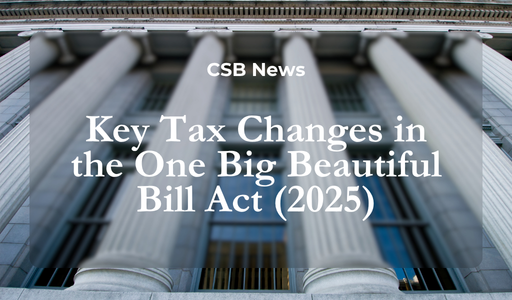Key Tax Changes in the One Big Beautiful Bill Act (2025)
The One Big Beautiful Bill Act (OBBBA) was signed into law on July 4, 2025, following narrow passage through Congress. Introduced in May 2025, the bill combines major tax reforms with changes to federal spending, building on the 2017 Tax Cuts and Jobs Act and modifying parts of the Inflation Reduction Act of 2022. You may be wondering what these changes mean for you. Below is a brief summary of key provisions that could affect your tax liability in 2025 and beyond.
For Individuals & Families:
- Lower Tax Rates Made Permanent: The reduced individual tax rates from recent years are now permanent, avoiding a scheduled increase after 2025.
- Higher Standard Deduction: The standard deduction is permanently increased (e.g., $23,625 for heads of household, $15,750 for singles).
- No Return of Personal Exemptions: Personal exemptions remain suspended, but seniors (65+) can claim a new $6,000 deduction through 2028, subject to income limits.
- Child Tax Credit Expanded: The child tax credit is now $2,200 per child, with inflation adjustments and stricter Social Security number requirements.
- State and Local Tax (SALT) Deduction Cap Raised: The SALT deduction cap increases to $40,000 ($20,000 for married filing separately) for 2025, with a phase-down for high incomes, before reverting to $10,000 after 2029.
- No Tax on Tips and Overtime (Temporarily): For 2025–2028, up to $25,000 in tips and $12,500 ($25,000 joint) in overtime pay can be deducted, subject to income phaseouts.
- Car Loan Interest Deduction (Temporarily): Deduct up to $10,000/year in interest on loans for new U.S.-assembled vehicles (2025–2028), with income limits.
For Businesses:
- 100% Bonus Depreciation Made Permanent: Businesses can fully expense qualified property immediately, with no scheduled phase-out.
- Section 179 Expensing Limit Increased: The limit for expensing business assets rises to $2.5 million, with a $4 million phaseout threshold.
- Research & Development (R&D) Expensing Restored: Domestic R&D costs can be fully expensed immediately; foreign R&D must still be amortized over 15 years.
- Qualified Business Income (QBI) Deduction Enhanced: The income threshold for phase-in is raised to $75,000 ($150,000 joint), and a $400 minimum deduction is established for active business income.
- Paid Family and Medical Leave Credit Expanded: The credit is now permanent and includes insurance premiums.
- Exception to Percentage of Completion Method for Residential Construction Contracts: The OBBBA expands the exception under IRC §460(e) to include “residential construction contracts,” not just “home construction contracts.”
Other Notable Changes:
- Estate and Gift Tax Exemption Increased: The exemption is permanently set at $15 million (indexed for inflation) for estates and gifts after 2025.
- Charitable Deductions for Non-Itemizers: Above-the-line charitable deduction increased to $1,000 ($2,000 joint) and made permanent.
- Energy Credits Phased Out: Credits for clean vehicles, residential energy, and other green initiatives are mostly terminated after 2025 or 2026.
- Enhanced Reporting Requirements: The 1099 reporting threshold increases to $2,000 (from $600), and the de minimis threshold for third-party network transactions returns to $20,000/200 transactions.
Temporary and Pilot Programs:
- “Trump Accounts” for Children: New tax-advantaged savings accounts for children under 18, with government-funded pilot contributions for newborns (2025–2028).
This is a high-level overview. Many provisions have specific requirements, phase-ins, or phase-outs. Given the scope of these changes, proactive tax planning is more important than ever. We encourage you to contact our office to discuss how the OBBBA may impact your specific situation and how we can help you plan effectively.

Jessica Eddlemon, CPA
Manager
Preparation of individual, partnership, and corporate tax returns.




